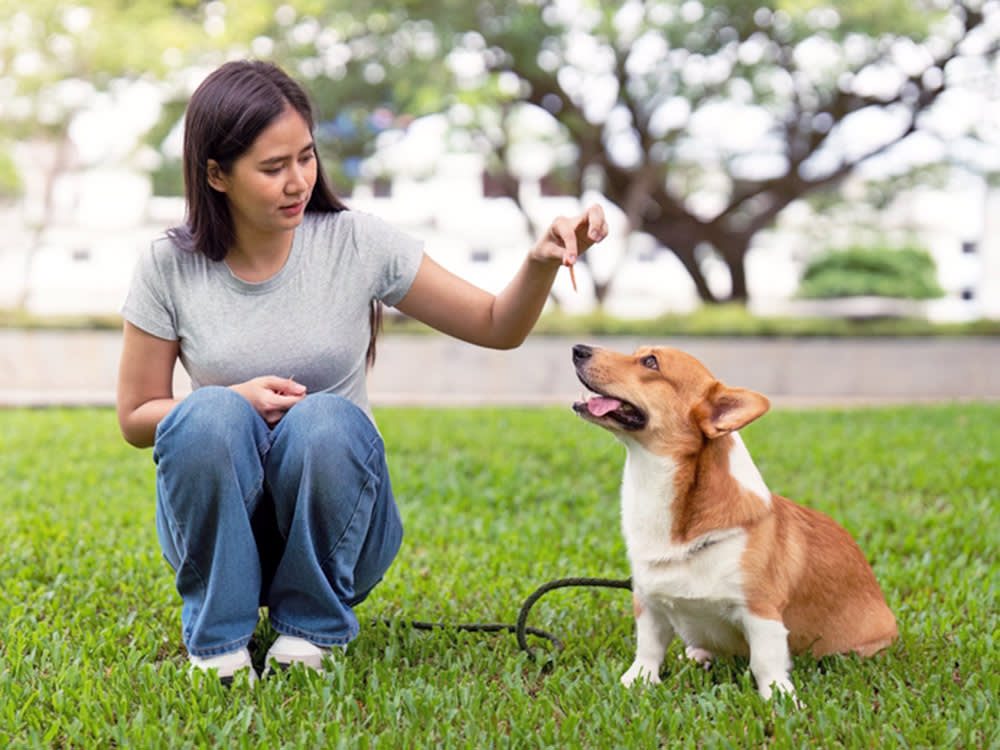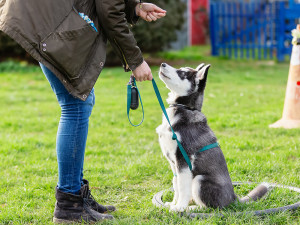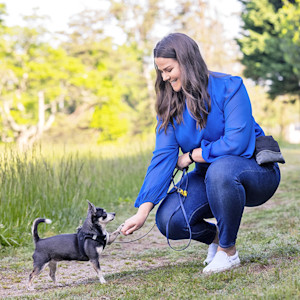Becoming a Dog Trainer: Steps, Costs, and Certifications
Learn what resources are helpful, which certifications you can earn, and more.

Share Article
In This Article:
What Is A Dog Trainer? How to Become a Dog Trainer? Step by Step Frequently Asked Questions
You want to become a dog trainer because you love dogs, right? Makes sense. But here’s the catch: Most of dog training is about people. A dog trainer’s job often involves teaching pet parents how to communicate with their dogs and stick to training programs.
Unless you work with service dogs or shelter animals, your success will depend on guiding humans as much as guiding dogs. If that still excites you, you’re on the right path.
How much do you spend on your pet per year?

What is a dog trainer?
Dog trainers do far more than correct undesired behavior. They help pet parents understand their dogs, strengthen relationships, and solve everyday challenges.
Trainers read canine body language, barks, tail wags, and posture to decode what a dog is feeling and how to respond. Good trainers act as translators, helping both ends of the leash understand each other better.
Beyond communication and behavior, dog trainers often educate families about enrichment, exercise, and mental stimulation that prevent future problems from developing. They may design customized training plans that address a dog’s unique temperament, environment, and history.
Trainers also act as resources for troubleshooting issues such as separation anxiety, leash reactivity, or introducing a new pet into the household. Many collaborate with veterinarians, groomers, and behavior specialists to provide comprehensive care. By combining technical knowledge with patience and empathy, dog trainers help set dogs and their humans up for long-term success, making everyday life smoother and more enjoyable for both.
How to become a dog trainer? Step by step
There is no single path to becoming a professional trainer. Many trainers are self-taught, while others apprentice with established professionals or attend academies. The best trainers combine different approaches and continue learning throughout their careers.
Step 1: Gather educational resources
Most people catch the training bug after working with their own dog or taking a class that inspires them. The first step is learning from books, videos, and seminars.
Recommended reading:
Canine Body Language: A Photographic Guide opens in new tabby Brenda Aloff
Don’t Shoot the Dog opens in new tabby Karen Pryor
The Culture Clashopens in new tab by Jean Donaldson
Excel-Erated Learningopens in new tab by Pamela Reid
The Other End of the Leash opens in new tabby Patricia McConnell
The Complete Idiot’s Guide to Positive Dog Training opens in new tabby Pamela Dennison
Seminars and conferences:
Events provide hands-on instruction and networking. Some of the most popular include ClickerExpo opens in new tab and the Association of Pet Dog Trainers (APDT) Conferenceopens in new tab.
Beyond books and conferences, there are countless online resources that can help new trainers build a foundation. Reputable YouTube channelsopens in new tab, podcasts, and webinars hosted by certified trainers or behaviorists can provide free or low-cost education. Many universities and veterinary schools also publish articles and research on canine behavior that are available to the public. Staying current with this research helps you understand not just how to train, but why specific methods work better than others.
It is also essential to seek out resources that emphasize positive reinforcement and force-free training. Modern dog training relies on science-based methods that reward desired behaviors rather than punishing mistakes. Trainers who commit to ongoing education in these areas will be better equipped to explain the process to pet parents and build trust with both the dogs and their families.
Keeping a training journal is another valuable tool at this stage. By recording what you read, watch, and practice, you create a personalized reference that highlights what resonates most with you. This will help you identify areas where you need more practice and ensure you are building a well-rounded knowledge base before moving on to hands-on experience.
Step 2: Gain dog training experience
Education is important, but hands-on work is where you will really learn. Apprenticeships are one of the most effective ways to get experience. Some academies build them into their programs, but many trainers offer informal mentorships or internships.
Volunteering at shelters is another excellent option. Shelters often teach volunteers how to train dogs to improve their adoptability. This might involve simple skills like waiting at doors or more complex behavior modification.
If your local shelter does not have a program, you can eventually help start one. Trainers often gain clients and referrals through this type of community involvement.
Example: Jill Dextrase of Sit Happens!opens in new tab in Calgary, Alberta, began as a student in a shelter class. She apprenticed for years before taking over her mentor’s business and now runs her own facility.
Another valuable way to gain experience is by working with a wide variety of dogs outside of formal training settings. Offer to help friends, family, or neighbors with their dogs so you can practice handling different personalities, energy levels, and problem behaviors. Each dog you work with will teach you something new, from basic leash manners to confidence-building in nervous pups.
You can also look into dog daycares, boarding kennels, or veterinary clinics that allow staff to practice positive training methods. These environments expose you to large numbers of dogs and give you insight into canine behavior in group settings. The more dogs you work with in different contexts, the stronger your skills will become, and the more prepared you will be to handle clients once you begin training professionally.
Step 3: Earn a dog trainer certification
The dog training industry is not government-regulated in the United States, but certifications help build credibility. Be cautious when evaluating schools. Some promote themselves as positive or humane while using harsh methods. Choosing carefully ensures you receive a reliable education, demonstrate professionalism, and build trust with future clients.
Certification Council for Professional Dog Trainers (CCPDT):
Offers the CPDT-KAopens in new tab (Knowledge Assessed) and CPDT-KSA opens in new tab(Knowledge and Skills Assessed).
Requirements include at least 300 hours of experience, a written test, and, in the case of CPDT-KSA, video submissions and hands-on evaluations.
Cost: $240 to $400, depending on the certificationopens in new tab
Academy for Dog Trainersopens in new tab (CTC Certification):
Founded by Jean Donaldson, former director of the SF/SPCA Academy.
Remote program with intensive video coaching, self-paced study, and exams.
Length: two years
Karen Pryor Academyopens in new tab (KPA):
Online coursework plus four in-person weekend workshops.
Curriculum includes training a non-dog species as part of graduation requirements.
Length: six months
Each certification has different strengths, but all provide structure, education, and proof of commitment to humane training methods.
Bottom line
Dog training is not just about teaching a dog to sit or stay. It is about helping people connect with their pets, building stronger bonds, and creating homes where both feel understood. If you truly love dogs and have the patience to guide their humans, too, this career can be gratifying.
Start with simple steps like reading a book, attending a seminar, or volunteering at a shelter. That is often enough to spark the passion that keeps future trainers moving forward.
Even after many years in the field, the best trainers keep learning. There is always more to discover about how dogs think, feel, and communicate. Skilled and compassionate trainers will always be needed to bring dogs and people closer together, and choosing this path means you can make a real difference in both their lives.
FAQs
How long does it typically take to become a dog trainer?
The timeline depends on the path you take.
Some people start working with dogs within a few months if they apprentice with a trainer or volunteer at a shelter, while formal certification programs can take six months to two years to complete. Since most certifications also require hundreds of logged training hours, expect the process to take at least a year if you are pursuing credentials seriously.
Does it make sense to specialize in a certain type of dog training?
Yes. Many trainers start with general obedience but later find a niche that matches their strengths and interests. Some specialize in behavior modification for fearful or aggressive dogs, while others focus on service dogs, agility sports, scent detection, or therapy animals.
Specialization can set you apart, attract the clients you most enjoy working with, and allow you to build deeper expertise in a specific area.
What are career opportunities for dog trainers?
Dog trainers can work in a variety of roles.
Common options include private lessons, group classes, and service or therapy dog preparation. You can also open your own dog training business. Others find work in shelters, boarding facilities, or veterinary clinics. Some expand into writing, online education, canine sports coaching, or detection work.
References
“Certification of Professional Dog Trainers and Dog Behavior Consultants.” CCPDT, 30 Apr. 2024, www.ccpdt.org/certification/opens in new tab. Accessed 1 Oct. 2025.
Hall, Nathaniel J., et al. “Working Dog Training for the Twenty-First Century.” Frontiers in Veterinary Science, vol. 8, no. 646022, 27 July 2021, https://doi.org/10.3389/fvets.2021.646022opens in new tab.
“Helpful Dog Training and Animal-Related Resources - CCPDT.” CCPDT, 3 Sept. 2025, www.ccpdt.org/resources/opens in new tab. Accessed 1 Oct. 2025.
Hiby, Elly; N. J. Rooney; and J. W. S. Bradshaw. “Dog Training Methods: Their Use, Effectiveness and Interaction with Behaviour and Welfare.” Animal Welfare, vol. 13, no. 1, 2023, Cambridge University Press, https://www.cambridge.org/core/journals/animal-welfare/article/abs/dog-training-methods-their-use-effectiveness-and-interaction-with-behaviour-and-welfare/B219F8FBE35C05DA269D02F310E38B66opens in new tab.
U.S. Bureau of Labor Statistics. “Animal Care and Service Workers : Occupational Outlook Handbook: : U.S. Bureau of Labor Statistics.” Bls.gov, 8 Aug. 2018, www.bls.gov/ooh/personal-care-and-service/animal-care-and-service-workers.htmopens in new tab.

Valerie Mellema
Valerie Mellema has a Bachelor of Science in Agribusiness and Equine Industry from West Texas A&M University. She has been a professional writer for the past 20 years, covering a wide variety of pet health and care topics before founding a nonprofit focused on mental health in children and thoroughbred aftercare. She has four Border Collies and eight retired racehorses.
Related articles
![Woman trains with a young husky on a dog training field]()
How to Find a Qualified Trainer for Your New Dog
The questions to ask and credentials to look out for to find the right trainer for your dog, according to a pro.
![Boston terrier being stubborn]()
Dog Training — DIY or Hire a Pro?
When it’s time to call in reinforcements.
![Juliana DeWillems, KPA CTP, is a member of the Karen Pryor Academy faculty.]()
10 Dog-Training Instagram Accounts You’ll Love as Much as Dogs Love Squirrels
The answer to your obedience questions—right there on your phone.
![Greyhound puppy sitting on her bed on the bedroom floor]()
Use Platform Dog Training to Elevate Your Pup’s Skills
Using platforms are favorites with pro dog trainers—here’s why you should add them to your training to-do list.
![A dog reaching up to grab a blue ball out of a woman's hand.]()
Playing With Dogs Improves Their Training Success
Post-training play may extend a dog’s memory of previously learned behaviors by up to a year.
![Young blonde woman with a Jack Russell puppy during spring in the city.]()
The Best Training Treats for Dogs in 2025
The most mouth-watering treats for training your pup.







